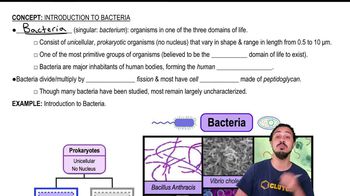Textbook Question
Match the following terms to the definitions in questions 1 and 2.
a. conjugation
b. transcription
c. transduction
d. transformation
e. translation
Transfer of DNA from a donor to a recipient cell by a bacteriophage.
125
views
 Verified step by step guidance
Verified step by step guidance



Match the following terms to the definitions in questions 1 and 2.
a. conjugation
b. transcription
c. transduction
d. transformation
e. translation
Transfer of DNA from a donor to a recipient cell by a bacteriophage.
Which of the following is not a method of horizontal gene transfer?
a. binary fission
b. conjugation
c. integration of a transposon
d. transduction
e. transformation
Match the following terms to the definitions in questions 1 and 2.
a. conjugation
b. transcription
c. transduction
d. transformation
e. translation
Transfer of DNA from a donor to a recipient as naked DNA in solution.